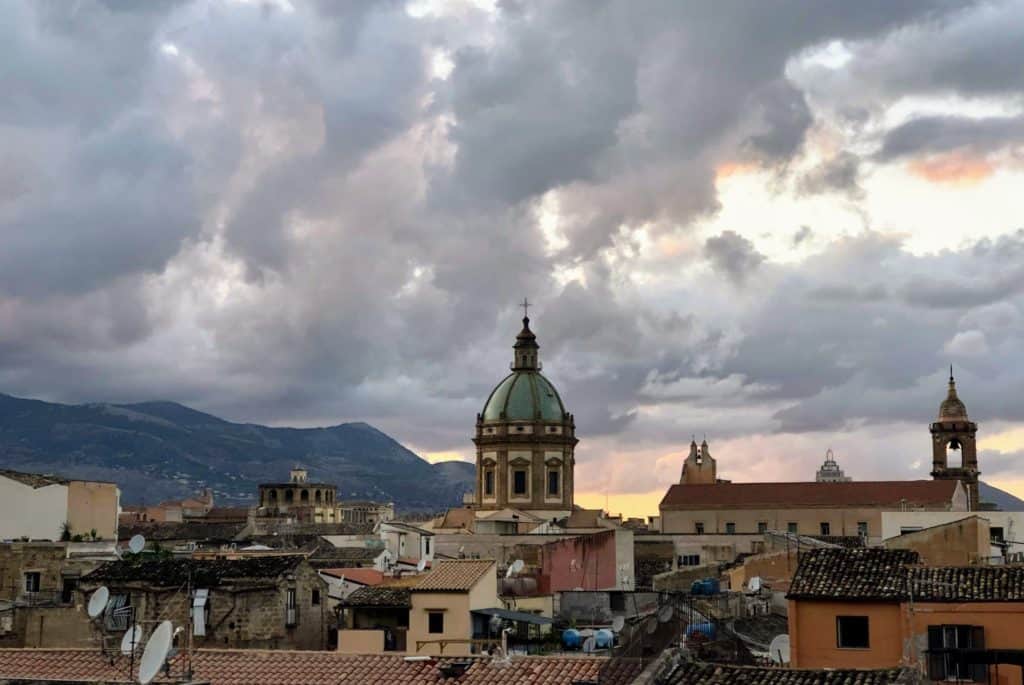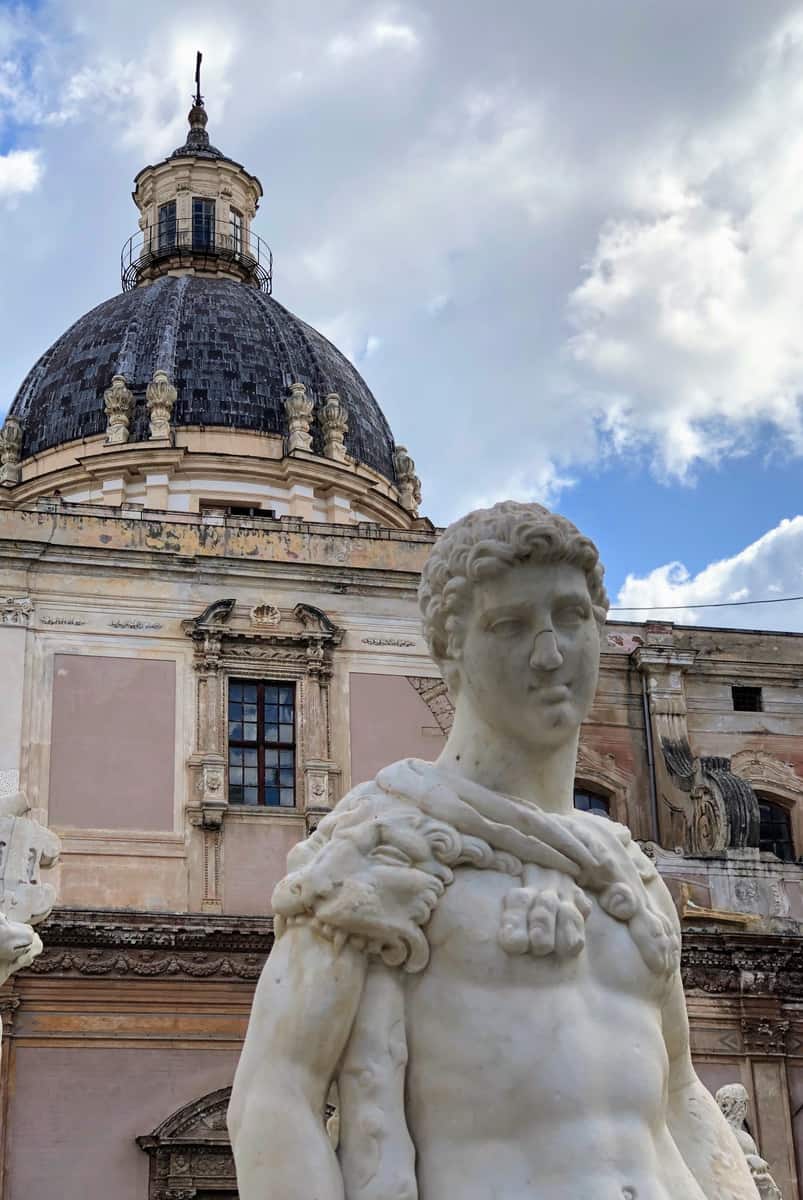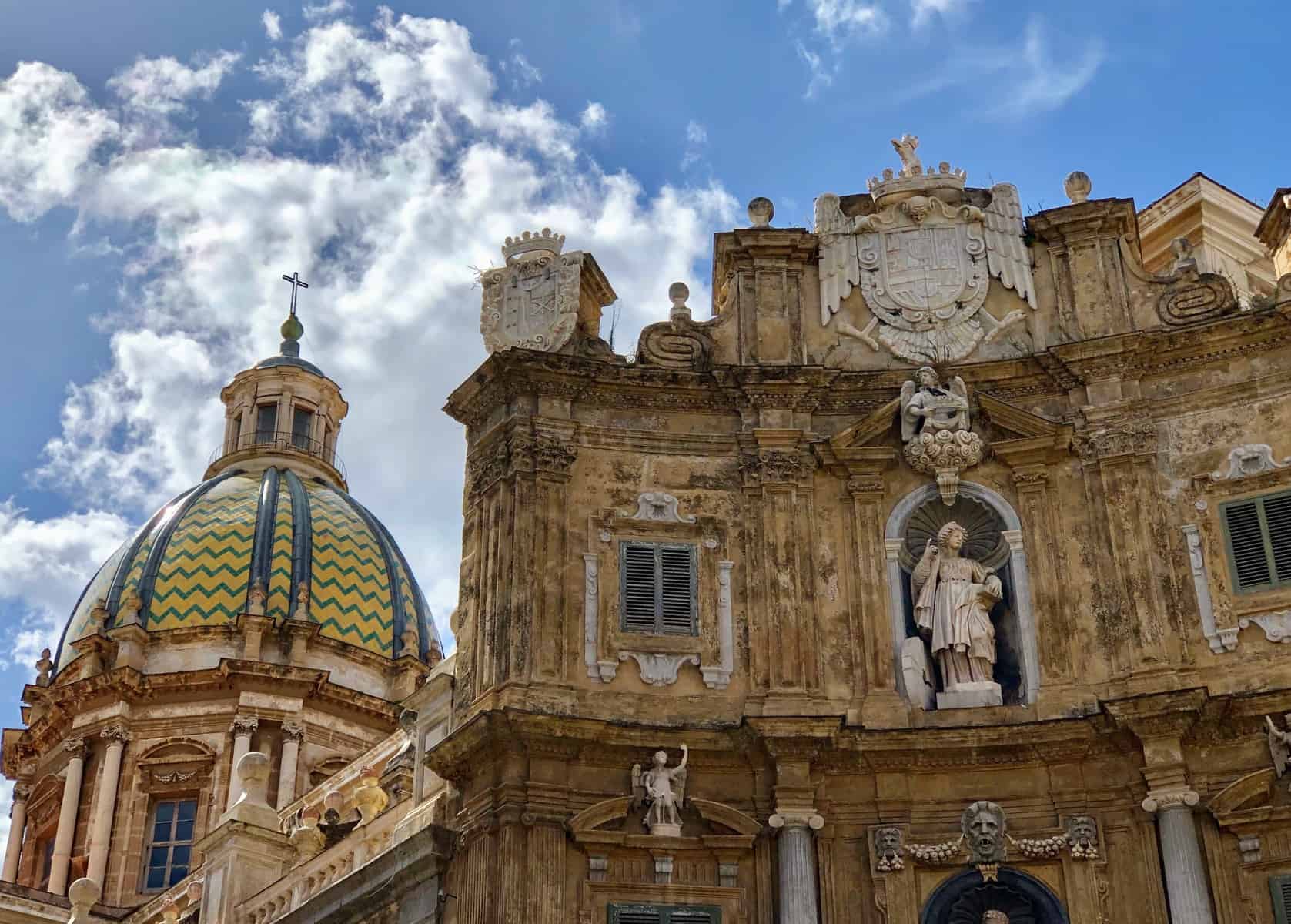A Guide to Palermo’s Architectural Curiosities
I made it less than five minutes on Palermo’s Via Maqueda before I had to stop and do a slow 360-degree turn. On either side of the street, three-story Baroque palazzi bloomed in the midst of decay. A string of wholesale bead emporiums sprouted from the ground floors on the block. Next to me, a man in full African regalia yammered into his phone. Some beefy guys in track suits gossiped over their shawarmas. A pair of ubiquitous nuns glided by silently, and a business man with an old-fashioned briefcase checked his watch as he scurried past. Further down the street, I spotted an ancient box of a building, with three stark, mysterious red orbs rising from the roof. Then I caught the patient gaze of a horse waiting by his cart. He wore a little straw hat. “Don’t worry,” he seemed to say, “We’re all mad here.”

I’d heard Palermo called “gritty” and I knew it had a cosmopolitan history. I didn’t realize that it may as well exist in a parallel universe.
I fell hard for Palermo’s quirkiness and what writer Stephen O’Shea called its “exquisite decrepitude,” but I should note here that not everything is odd or dilapidated. For all the “character” of the locals, they struck me as a cheerful, highly functional lot. With the exception of one adventure finding a regional bus station, we never experienced logistical confusion.

That said, if it breaks your heart to see beautiful buildings in disrepair, or if you like your world polished and logical, Palermo may not be the place for you. If you’re willing to embrace the city’s complexity and diversity, however, you may find yourself bewitched by the mosque-castle mashups and street markets open after midnight. Palermo is a European city with its doors open to Africa and Asia, ancient and modern at the same time.

Four (Non) Corners
Arabs conquered Palermo in about 831, and the old city revolves around a road rather than a piazza. Originally this thoroughfare led from the port to the main mosque, now the site of the city’s cathedral. Today, the Via Vittorio Emanuele extends far beyond the historic center, but the streets around it are still filled with a typically Islamic labyrinth of small side streets and alleys.

The Quattro Canti, or “Four Corners,” lies at the intersection of the of the Via Vittorio Emanuele and the Via Maqueda, making a handy orientation point. Not that there are any corners to be seen there, because the blocks were scooped out to make an oval. Four matching Baroque concoctions on each side echo the curve, turning the space into a vortex.
Each building façade has three tiers. On the ground, fountains representing Palermo’s four rivers are topped by a statue representing the seasons. The next level features Spanish kings (three Philips plus a Charles) and the top tier has Palermo’s patron saints (three women, one man).
Fountain of Fun
Just down the Via Maqueda from the Four Corners lies another famous landmark: the Renaissance era Fontana Pretoria, better known as the Fountain of Shame.

Steps lead from the street to the elevated piazza, where a ring of 16 marble statues surrounds a massive circular fountain. Using Greco-Roman mythology as subject matter is certainly typical of the Renaissance, but from there things start get weird. First of all, I suspect power struggles plagued the sculptor’s workshop, because some of the statues are beautiful and others are a bit … awkward. Second, I couldn’t sense a plan for what went where, or whether the unfinished portions on some statues were stylistic or indicative of a different overall design. Walking around turned into a visual treasure hunt.


Then there are the animal heads. There are 24 of them spouting (or dribbling) water all around the circumference of the fountain. Like the statues on the outside, some look more anatomically correct than others. In this case, however, it seems to have been a matter of access to models rather than skill. What with the goofy expressions, I dare anyone to choose just one as a favorite.

Why is it called the Fountain of Shame? No one can say for sure. One theory suggests it’s a reference to the cost of having all 644 pieces shipped from Florence. Personally, I prefer the legend of nuns sneaking out one night and attempting to chisel off the unseemly genitals.
San Cataldo and La Martorana
Continue down the Via Maqueda and you’ll hit the Church of San Cataldo. It’s not beautiful, but those otherworldly domes looming from the cube penetrate your consciousness on a primal level. They’re so stark you’d be forgiven for thinking them unfinished – except the San Giovanni degli Eremiti has them, too.

Inside, the church shifts from Arabic to Byzantine mode, albeit with a curiously raw finish. Bare brick walls and vaulting contrast with the spolia (repurposed) marble columns and elaborate altar. The floor is covered with an intricate marble pattern. Mostly, though, the views are up high, where light coming through clerestory windows plays on the interior of the domes.

The Santa Maria dell’Ammiraglio sits next to the San Cataldo and also dates back to the mid-12th century. Like other buildings of the era, the church combines Byzantine and Arabic elements with Latin Romanesque architecture.

Exquisitely detailed and incredibly preserved mosaics rival even the cathedrals of Cefalù and Monreale, albeit on a smaller scale. La Martorana, the convent next door, eventually absorbed the building and added the Baroque portions. In a nice echo of Norman-era tolerance, this church also provided a refuge for Albanians fleeing persecution in Ottoman Turkey.
The Mix And Match Cathedral

Architectural purists may not care for the Palermo cathedral’s mishmash of styles, but it is clearly beloved by residents. I admit the Arab-Norman elements on the exterior are the best part, but the Romanesque bell tower and Baroque dome bear witness to the building’s continuous use. The streets around it were thronged with teenagers, all of whom seemed thrilled to be there.

Once again, there’s plenty for history buffs. Most important, perhaps, are the tombs of Sicily’s greatest king, Roger II, and his grandson, Frederick II. The latter ruled Sicily as Holy Roman Emperor and contemporaries called him stupor mundi, or “wonder of the world” – except for the pope, who called him the Anti-Christ.

The busiest part of the cathedral was a chapel dedicated to Pino Puglisi, a priest murdered by the Mafia in 1993. Pictures and letters accompanied information about why he encouraged people to resist the Cosa Nostra (“Our Thing”). News outlets focused on high-profile trials, but a generation of residents helped subdue the Sicilian Mafia on an everyday level. It still exists, but doesn’t dominate Palermo the way it did a few decades ago.

Palermo’s Markets
You’d need at least a week to explore all of Palermo’s markets. Many operate every day, but there are also specialty markets on various days of the week or month. Some, like La Vucciria, are busier at night. The daily Mercato Ballaro occupies a sizable swathe of the old city center. At the Corso Turkory end, the food area alone has hundreds of stalls. From there, setups get more informal – sometimes just a blanket on the ground – and the pickings more diverse. The kitchen implements zone, for instance, had subsections for cheap plastic imports, vintage pieces, and high-end handmade items. The music section had cassette and 8-track tapes. Sneakers took up a full block. I wandered through zones for cleaning supplies, car parts, and costumes.
The Old New Gate
On our last day, we wandered around the waterfront and through the Botanical Gardens, before getting distracted by some Roman ruins. Finally, we stopped at a café on a mini-piazza surrounded by Baroque buildings. Sipping my lemon granitas, I noticed that the buildings were festooned with dozens of colorful corrugated plastic tubes, the kind used to protect electric cables. I’m pretty sure they were functional, but I couldn’t fathom how. Why did one particular window need a direct line to another particular window across the way?


We ended at the Porta Nova, a fitting transition between the old and new parts of the city. The Viceroy who commissioned it in 1536 intended to symbolize Western triumph over the Moors. But to my contemporary eyes, the figures’ brawny muscles and massive scale makes them look more than a little heroic. For more on Arab-Norman architecture, see our posts linked below.

More Sicily
Italy’s Most Stunning Mosaics from Rome to Ravenna to Sicily

